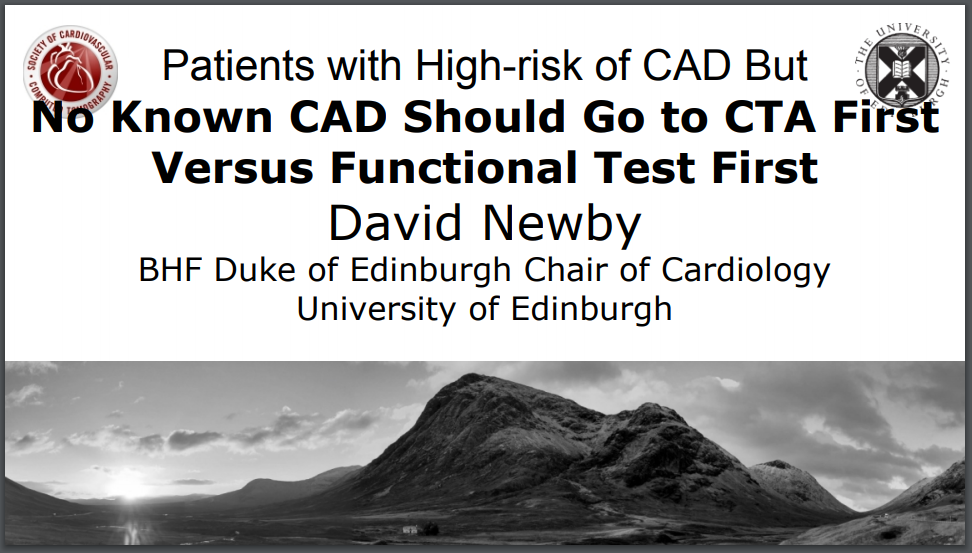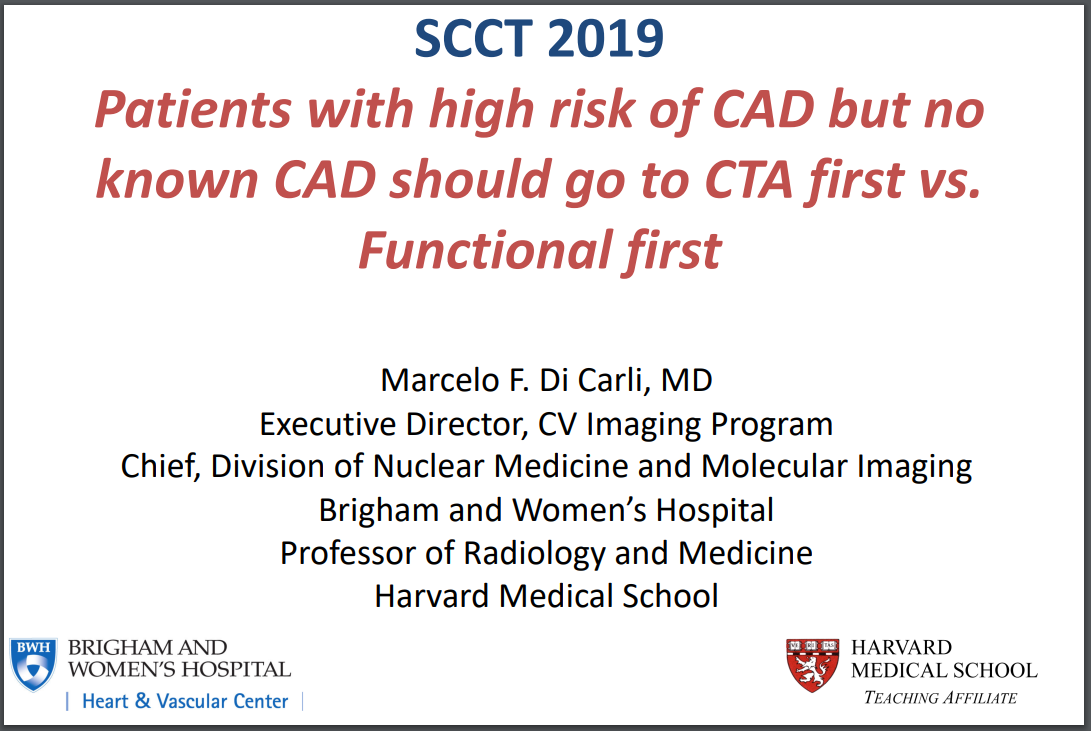CTA or Function Tests in High-risk Chest Pain and No Known CAD: Debate Goes On
It’s a question that’s been debated for years: which is the best first test in this specific patient group?

BALTIMORE, MD—In patients with chest pain who are at high risk for CAD but have no known disease, evaluation with coronary CT angiography (CTA) is associated with an improvement in long-term outcomes as compared with function tests, while functional testing—namely quantitative positron emission tomography (PET)—may be better suited to identifying patients at low risk for events who can be sent home without treatment. That was the upshot of the latest debate to tackle this topic, this one during the annual Society of Cardiovascular Computed Tomography (SCCT) meeting last week.
“We've done this debate many times at SCCT comparing anatomy versus functional testing,” session co-moderator Ron Blankstein, MD (Brigham and Women’s Hospital, Boston, MA), told TCTMD. This time around, the question was framed around patients at high risk for CAD because the available data on CTA has deemed this issue “no longer a debate, at least in this community” for individuals at low and intermediate risk.
In a pre-debate audience poll, approximately 85% of attendees said they favored beginning with CTA in this cohort, while about 15% said they would start with functional testing.
“Well, we are at a CT meeting,” acknowledged Stephan Achenbach, MD (University of Erlangen, Germany), who also served as a moderator of the session.
CTA a ‘No-brainer’
Arguing for the merits of beginning with a coronary CTA approach, SCOT-HEART primary investigator David Newby, MD, PhD (University of Edinburgh, Scotland), started off by reminding the audience that physicians should be focused on patients’ needs. “They don't care about pretest probabilities and all the other tests that I've got in my tool bag that I really want to use,” he said. “They just want to ask simple questions: What is my chest pain? Have I got coronary disease? Have I got heart disease? Are you really going to have to take me to the cath lab? What treatments are you going to give me? Can you please get rid of these symptoms? And please, I don't want to have a heart attack and that's what I'm really afraid of.”
The specificity and sensitivity of functional tests for diagnosing CAD are “not bad,” hovering around 80% to 90%, Newby said. However, CTA has been shown to be much more accurate, reaching a sensitivity of 98% in one meta-analysis. “Show me a functional test that can give you that,” he said. “There isn't one.”
It’s “clear” that CTA is superior for diagnosis because both patients and physicians “can actually see if they’ve got disease,” Newby continued, citing data both from SCOT-HEART and a study comparing myocardial perfusion imaging and CTA.
For me, it’s really a no-brainer: you’ve got to get a CT. Why would you ever bother with a functional test? David Newby
Based on PROMISE and SCOT-HEART data, CTA is also the “best gatekeeper” for the cath lab, with patients less likely to have normal coronaries and nonobstructive disease after being screened by CTA versus functional testing. “If you have a CT first, the vast majority of the time you don‘t even need an invasive angiogram and you can go home,” Newby said. “We know from CONSERVE that if you actually randomize, 96% of people don’t even need an invasive angiogram and it’s half the price. So why would you? That's the gold standard. We're not even considering a functional test because CTA is so good, you can go straight for comparisons with invasive angiography.”

Newby pointed to a common criticism of CT—that it increases rates of coronary revascularization—but indicated that he doesn’t think that’s a problem. “Of course, if you find disease you need to treat it. Why should we apologize for increasing revascularization?” he asked. “As we've recently found, whilst it does increase revascularization rates at the beginning, subsequently you get less revascularization with CT because you've found the disease and because you get the right treatments. You give more appropriate therapies, you increase preventative therapy, and actually when you use CT to find out whether they’ve got disease, patients are much more likely to take the treatment.”
With regard to impact on symptoms, Newby acknowledged that the data comparing functional testing and coronary CTA don’t suggest a lot of difference. “I think it's very difficult to change the symptoms of angina when people have not ultimately been diagnosed, he said. “But obviously we have lots of treatments, we have lots of drugs which we can use, and it would be very difficult to do that. It’s a draw really when it comes to symptoms.”
Lastly, for MI prevention, CT has been shown to have “much better risk prediction” compared with functional testing, Newby argued. “Half the MIs occur in people who have a normal functional test. It really isn't that sensitive,” he said.
Other than a “neutral outcome” on symptoms, “CT beats functional testing” for everything else, Newby concluded. “For me, it’s really a no-brainer: you’ve got to get a CT. Why would you ever bother with a functional test?”
Functional Testing First
Taking the opposite side, defending functional tests, Marcelo Di Carli, MD (Brigham and Women’s Hospital, Boston, MA), opened by defining his position. His “debate assumption,” he said, is that he was asked to debate how best to triage patients with high-risk coronary disease without known disease, “and to me that equates cardiometabolic disease. Why is that? Because it is the problem we’re going to have to confront in the next few years. Obesity, diabetes, and their complications are rampant in this country and in the rest of the world.”
With that, he gave the example of 68-year-old obese man with hypertension and type 2 diabetes who is on treatment and presents with atypical angina and dyspnea. “I looked at his 10-year risk and it was 39.9%,” Di Carli said. However, on CT, “you can see of course that there's a lot of disease that was noted in that. And guess what happened? He went to the cath lab and they found that yes, he had diffuse atherosclerosis, but there was no significant obstructive coronary disease to be found on the angiogram.”
Following continued symptoms, the patient came back for assessment, which was done with a PET scan, and it was “essentially normal, but his flow quantification was essentially showing what we saw on the invasive angiogram, that the pattern corresponds to a patient with diffuse nonobstructive atherosclerosis which reduced peak flow but [kept] normal flow reserve.”

In screening for coronary disease in high-risk patients, Di Carli said the question is: “What are we trying to diagnose?” Testing atherosclerosis “will only confirm what we sort of already know in this patient population. . . . I don't need to do a CT to tell you that you're likely to have coronary disease. And yes, when you do that anatomic test, you will be enticed to do more tests. And that ‘more tests’ usually is revascularization and coronary angiography.”
He acknowledged that SCOT-HEART convinced him that finding atherosclerosis on CTA can change patient management, “but in patients whom we already know have atherosclerosis, do we need a test to do the right thing, which is to treat the patient?
Perhaps, our effort should not be on doing more CT, but rather on educating people that they need to treat these high-risk individuals, and this is irrespective of how much disease they have. Marcelo Di Carli
“Perhaps, our effort should not be on doing more CT, but rather on educating people that they need to treat these high-risk individuals, and this is irrespective of how much disease they have,” Di Carli continued.
The PACIFIC trial showed that quantitative PET “is the most accurate test we have for looking not just at atherosclerosis but at flow-limiting coronary artery stenosis,” he highlighted. Moreover, with this test, “you will be able to achieve exquisite risk stratification, identifying the truly low-risk individuals” by receiving information regarding the extent of focal disease with a “very high” sensitivity and negative predictive value. “I will add a CAC [coronary artery calcium] score . . . because this adds information that will help us interpret the quantitative information regarding diffuse atherosclerosis and microvascular disease,” Di Carli added.
Identifying flow abnormalities can more precisely guide the need for revascularization, so that “rather than just revascularizing the stenosis, [we are] revascularizing those patients who have abnormal flow reserve to begin with,” Di Carli concluded. “A quantitative PET is the test of choice for patients with high-risk cardiometabolic disease. The CT will only give us the information that we already know from the patient's profile and would not be in general the first-line testing for this population.”
The Final Vote
In his rebuttal, Newby said he enjoyed Di Carli’s case because it “beautifully demonstrated my argument.”
“I'm sure you all noticed that Marcel actually showed the CT coronary angiogram first, so obviously he’s bought into doing a CT coronary angiogram first,” he said. “And then the next two tests, the invasive angiogram and the perfusion scan, didn’t add any value because you had all that information already in the CTA.”
Ultimately perfusion scans and functional tests over the years have all been based on risk scores, but the risk stratification “is so much stronger for CTA,” Newby said.
However, Di Carli argued that the PET scan in his patient was needed and did add value because the patient continued to have symptoms and the question of microvascular disease remained. “It seems to me,” Di Carli replied to Newby, “that you’re so enamored with the lumen that you forget that the coronary circulation is more than just what you see,” he said. “There's a lot more that you don't see and you have to really measure. At any rate, it added value and so I think the anecdotal case made the point that when you start with the CT you really end up having more unnecessary testing that doesn’t necessarily help you guide how you are going to treat the patient in the end.”
PET is an outstanding test that combines a lot of data and can do a quantitative assessment of blood flow, and I think if the debate was between PET and CTA in these high-risk patients, I do think PET in many of those scenarios could be my preferred test. Ron Blankstein
Discussing the debate with TCTMD, Blankstein said “there certainly is equipoise, in my opinion, and you can start with either test.” Blankstein agreed, he said, with Di Carli’s assumption that these are patients who one can assume already have coronary disease and hence are receiving aggressive medical therapy. “We don't need to do a CT just to tell us that someone had plaque if they're truly in that high-risk group.”
Additionally, “PET is an outstanding test that combines a lot of data and can do a quantitative assessment of blood flow, and I think if the debate was between PET and CTA in these high-risk patients, I do think PET in many of those scenarios could be my preferred test,” Blankstein observed. However, he added that he would choose CTA over a test like single-photon emission CT (SPECT) where “the diagnostic accuracy is not as good.”
At the conclusion of the session, Achenbach commented that Di Carli “was speaking about PET as though it was the only functional test around, which is certainly not the case.”
Blankstein acknowledged that “one of the limitations of a debate like this is when we say, ‘functional testing,’ they're not all the same, and the accuracy of whether it's a stress echo or a SPECT or a PET or an MRI is different. I think many of us who do multimodality imaging know that and for the sake of making the debate simple, we call it functional testing. But the reality is there's a lot of different functional tests and they do perform differently.”
Yael L. Maxwell is Senior Medical Journalist for TCTMD and Section Editor of TCTMD's Fellows Forum. She served as the inaugural…
Read Full BioSources
Newby D. Patients with high risk of CAD but no known CAD should go to CTA first versus functional test first. Presented at: SCCT 2018. Baltimore, MD. July 13, 2019.
Di Carli MF. Patients with high risk of CAD but no known CAD should go to CTA first versus functional first. Presented at: SCCT 2018. Baltimore, MD. July 13, 2019.
Disclosures
- Newby reports having grants, consultancy, or clinical trial contracts with Abbott, Amgen, AstraZeneca, BMS, Boehringer Ingelheim, Eli Lilly, GE, GSK, Janssen, MSD, Novartis, Pfizer, Philips, Roche, Sanofi, Siemens, Toshiba, UCB, Wyeth, and Zealand; publishing with BMJ Group and Elsevier; serving as the chief investigator of the SCOT-HEART trial; and receiving research funding from the British Heart Foundation, Medical Research Council, Wellcome Trust, Chief Scientist Office, and Chest Heart Stroke Scotland.
- Di Carli reports receiving research grants from Spectrum Dynamics and Gilead Sciences; consulting with GE Healthcare and Sanofi; and receiving funding from the National Heart, Lung, and Blood Institute.


Comments